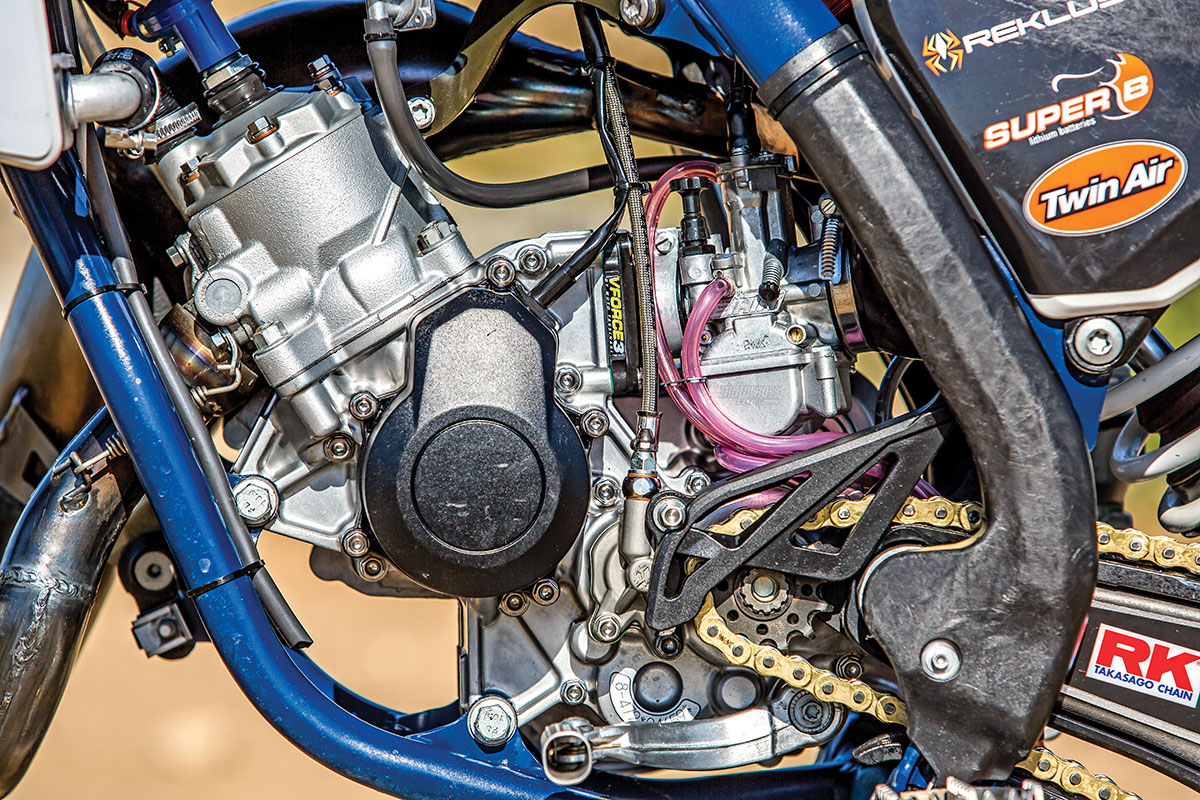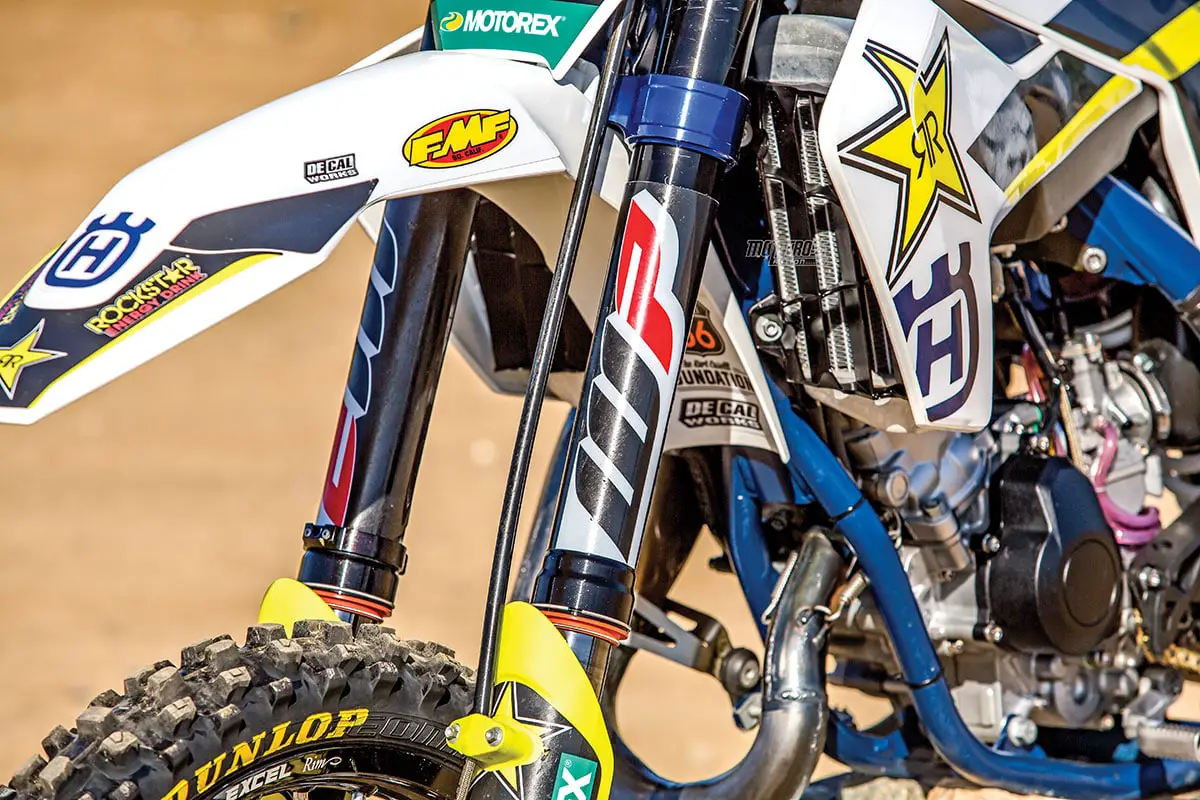WE RIDE TIMMY WEIGAND’S HUSQVARNA TC112 WORLD TWO-STROKE POP GUN
A dirt bike is built around the height of an average male, which is 5 feet, 9 inches tall. So, what happens if you are an adult male who is vertically challenged? Do you drop down to a minicycle that fits your stature, or deal with a bike that you can’t touch the ground on? It seems, for the most part, many of the best racers have been shorter than average. Ricky Carmichael was one of the shortest champions in the sport, standing 5-foot-6. James Stewart was 5-foot-7 and Ryan Villopoto was 5-foot-8. It is no secret that short stature pays dividends in body weight, on jumps and in tight corners while hindering riders in the whoops. But what about a rider who is 2 inches shorter than Ricky Carmichael?
IT IS NO SECRET THAT SHORT STATURE PAYS DIVIDENDS IN BODY WEIGHT, ON
JUMPS AND IN TIGHT CORNERS WHILE HINDERING RIDERS IN THE WHOOPS.
Standing at 5 feet, 4 inches, retired professional racer and now Husqvarna off-road team manager Timmy Weigand raced three seasons of Supercross, with his best finish of sixth in the 250 West at the 2003 Anaheim III Supercross. Imagine blitzing Supercross whoops that are half your height. When Timmy stood up on the bike, it looked like he was sitting down. Despite being short, Timmy never looked at it as a disadvantage. Timmy was known for his work ethic and became a four-time Baja Champion after his stint in AMA motocross and Supercross.

If you have red hair; if you are 6-foot-11; if you have a big nose; if you are fat; and if you are short; other racers will tease you no matter how successful you are on a bike. Timmy was short—and he knew it. But, he didn’t let it define him. After his successful off-road racing career, Timmy became the Husqvarna off-road team manager, but it didn’t mean that he had retired from racing, only that he was busy guiding Husqvarna’s giants of off-road.
When his schedule permits it, Timmy dons his gear to race the Wiseco World Two-Stroke Championship. He was fifth overall in the 2016 event, and this year his Husky colleagues wanted him to race the 125 World Two-Stroke Championship on a mini bike. It was a crazy idea on several levels. First, this wasn’t a local race. It was serious business against professional motocross racers bent on making a name for themselves. Second, Glen Helen’s World Two-Stroke track was of epic length and roughness. It had braking bumps bigger than the wheels on a minicycle. Third, Timmy is no spring chicken at 40 years old. The only rider older than Timmy in the Pro classes at Glen Helen would be 47-year-old Mike Brown (Brown had learned his lesson racing against the youngsters in the 125 Two-Stroke class and had moved to the Open class). Fourth, Timmy had no recent experience racing a minicycle, least of all in a major event—not since his days as a minicycle racer, which were almost 25 years earlier.
THERE IS LITTLE DOUBT THAT TIMMY THOUGHT THAT IN THE MIDDLE OF AN INCREDIBLY BUSY OFF-ROAD RACE SEASON THERE WAS NO WAY THE TEAM WOULD BE ABLE TO PULL IT ALL TOGETHER IN THE LIMITED TIME REMAINING.
As the Husqvarna off-road team egged him on, Timmy was game to give it a try, but it had to be on his terms. One, he didn’t want anything to do with building the bike. Two, he wanted the bigger SuperMini. Three, he wanted to be able to test the bike before agreeing to race it. There is little doubt that Timmy thought that in the middle of an incredibly busy off-road race season there was no way the team would be able to pull it all together in the limited time remaining. But, they did. The Husky crew built Timmy a full-fledged Husky SuperMini. Timmy didn’t take into account that Husqvarna has a full-fledged minicycle team, which made the job of building him a SuperMini as easy as borrowing parts from the machines of the Husky mini stars.

Timmy’s race bike was built in-house with a TC85 chassis, larger 19/16 wheels, TC125 rear brake, big bike Raptor footpegs and an 85cc engine that was bored out to a 105cc and stroked to a SuperMini legal 112cc. This engine ran on $35 per gallon VP MXR02 and was so temperamental that it had to be rejetted every time it was ridden. Not just every day it was ridden, but each time it went out on the track on the same day. Since this is a full factory engine it had some trick technology mated to it. The TC112 engine was tuned to a device called a Raceair Pro that is made by Comutech. This device samples the air and spits out a code. This code then correlates to a main jet size determined by a jetting chart made in house. What about the pilot or air screw? In house techs calibrated the jetting device, engine, one-off FMF pipe and carburetor to work together in such a way that only the main jet would need to be adjusted for different weather conditions. The icing on the cake was WP XACT Cone Valve Air forks. For all intents and purposes, Weigand had a works SuperMini.

On the starting line at Glen Helen, Timmy looked like he could have been the father of the majority of riders—many of them aspiring AMA 250 Supercross hopefuls. When the gate dropped, the fans could tell where Timmy’s Husky TC112 was by the unique high-rpm pitch of its big-bore SuperMini engine. We don’t know how much money the Husky mechanics had bet on Timmy failing, but, when the two motos were over, the 40-year-old was sixth overall in the 125 Pro class. He was surprised, happy and tired.
THE MXA WRECKING CREW TESTS TIMMY’S SHUSQVARNA TC112 SUPER MINI
Of course, after the checkered flag fell, MXA asked Husqvarna’s Andy Jefferson about getting the bike for a test. Two days later, MXA met Husqvarna at the test track to ride Weigand’s Husqvarna SuperMini. When we asked Timmy how the bike was, he said the power-to-weight ratio made the SuperMini faster than most 125cc bikes that he had ridden (as it was 30 pounds lighter than a TC125). What he liked most about the bike was its aggressive roll-on power from the crack of the throttle. Our testers agreed. There was no need to downshift extra gears entering corners to ensure that you’d have drive on the exit. The shift points were identical to those on a Husqvarna TC125 but with more power coming out of corners. Timmy, as well as the MXA test riders, reported that he never needed to feather the clutch to keep the power in the meat of the powerband. What about the top end? It revved to the moon, which was a good thing, because to get the most out of the Husky TC112 engine you had to use every last rev. This was the ultimate top-end powerband. It was best to get as close to the rev limiter as possible before shifting to the next taller gear. That was where the sweet spot was. If you short shifted, it would take some time to get back on the pipe.

Every MXA test rider felt this small but mighty bike was faster than a YZ125, TC125 or 125SX in stock trim. The combination of the pumped-up engine and ultra-light chassis could really haul the mail. Timmy admitted that the small chassis was twitchy on Glen Helen’s big bumps and that the short wheelbase wasn’t always on the same bump-to-bump frequency as the bigger bikes that made them. But when the track got a lot rougher in the second moto, the small chassis was an advantage, as Timmy was able to cut through the nastiest sections whereas the big bikes had to plow through them. Passing became a lot easier because he could maneuver the little bike through smooth lines that no one else could get to.
MXA’s minicycle test riders had Husky SuperMinis of their own and were used to the short wheelbase. They loved the way Weigand’s TC112 handled. His suspension was dialed in for our 14-year-old test riders. That was a surprise, because Timmy is quite a bit heavier than the average minicycle racer. But, two things came into play to make everyone happy: (1) Timmy felt that the valving on the WP XACT Air forks was a little light for his weight, which meant that it worked great for our test riders. (2) The XACT Air forks can be adjusted for rider weight with an air pump. Timmy ran higher pressures than the MXA test riders.

Almost every AMA Pro has been goaded into doing something crazy. We’ve seen AMA National Champions at local races on XR80s trying to beat their Vet Expert buddies—and succeeding. But, we’ve never seen a former AMA Pro and current team manager bring a pop gun to a gunfight and exceed expectations. The capabilities of Weigand’s 2019 Husqvarna TC112 SuperMini blew us away. The most obvious conclusion? Don’t feel bad when a mini bike blows by you. After all, they have a better power-to-weight ratio. At least that’s what we tell ourselves.







Comments are closed.